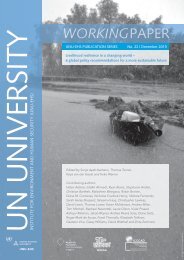k5q82a3
k5q82a3
k5q82a3
Create successful ePaper yourself
Turn your PDF publications into a flip-book with our unique Google optimized e-Paper software.
Box 2.3: Parametric index insurance<br />
Parametric indexes enable pre-defined payments that are based on expected losses, correlated<br />
against a measurable parameter (such as rainfall, temperature or earthquake intensity) or index of<br />
parameters. Traditional indemnity insurance relies on costly verification of actual losses whereas<br />
parametric insurance allows payments to be triggered automatically when pre-agreed risk thresholds<br />
are breached. Dispensing with the need for verification allows substantial savings to the insurer.<br />
These savings are reflected in reduced premium costs, making parametric insurance a more<br />
affordable product for low-income purchasers.<br />
The prior agreement of payments and trigger thresholds, combined with independent measurement of<br />
data, also allows for much more rapid disbursement of payouts and reduces the risk of moral hazard.<br />
Parametric indexes have been used widely in micro-insurance products such as the Kilimo Salama<br />
Agriculture Index Insurance in Kenya and MiCRO micro-catastrophe insurance in Haiti. Recent<br />
innovations include payments triggered in advance of expected losses based on modelled expected<br />
climatic conditions such as the Extreme El Niño Insurance Product in Peru.<br />
Parametric indexes have also been used as the trigger for catastrophe bond payouts and are used to<br />
trigger access to the International Development Bank (IDB)’s contingent credit facility, avoiding the<br />
potential for moral hazard when disaster declarations are used as triggers.<br />
Parametric indexes have also been developed to trigger payouts through regional risk pools such as<br />
the Caribbean Catastrophe Caribbean Catastrophe Risk Insurance Facility (CCRIF); the Pacific<br />
Catastrophe Risk Assessment and Financing Initiative (PCRAFI); and the African Risk Capacity<br />
(ARC).<br />
One notable draw-back compared with traditional loss assessment is the increased likelihood of<br />
‘basis-risk’, which is a disparity between actual losses and losses calculated by the index such that<br />
people who might have been seriously affected might not receive a payout and vice versa.<br />
There is a convergence of interests across the public and private sector. The global<br />
insurance industry is increasingly interested in working in partnership with international<br />
actors to extend insurance products to developing countries, especially where this might<br />
otherwise have been considered unprofitable and excessively risky. Governments and lowincome<br />
individuals are seen by a growing number of global reinsurers as middle-income<br />
clients of the future and early engagement in these markets has become a long-term<br />
business strategy. 5<br />
The prospect of leveraging the resources and technical expertise of the private sector in<br />
building resilience is appealing to donors and affected governments alike. For example, the<br />
development of agricultural index insurance and sovereign risk-financing are noted as<br />
priorities for public-private sector action under the 2012 New Alliance for Food Security and<br />
Nutrition, and are being closely observed by many development policy makers. 6 The Political<br />
Champions Group for Disaster Resilience identified co-operation with the private sector as a<br />
priority in 2012, with the United Kingdom proposing targeted support to the insurance<br />
industry. The Political Champions launched a new initiative in 2013 to jointly target the<br />
scaling up of market-mediated risk insurance in several low-income case study countries. 7<br />
Political commitments and demand are growing. Risk financing is recognised as a<br />
priority in the Hyogo Framework for Action 2005–2015 and there have been further highlevel<br />
political affirmations of the importance of risk financing have in the last three years.<br />
For example, risk financing was identified as a priority of Mexico’s presidency of the G20 in<br />
2012. This led to high-level statements of commitment from G20 members and a joint<br />
publication that marshalled the experiences of 15 governments and focused on improving<br />
the assessment of disaster risk and strengthening financial resilience. The G20 and OECD<br />
produced a joint methodological framework on disaster risk assessment and risk financing in<br />
A CALCULATED RISK: HOW DONORS SHOULD ENGAGE WITH RISK FINANCING AND TRANSFER MECHANISMS<br />
7



